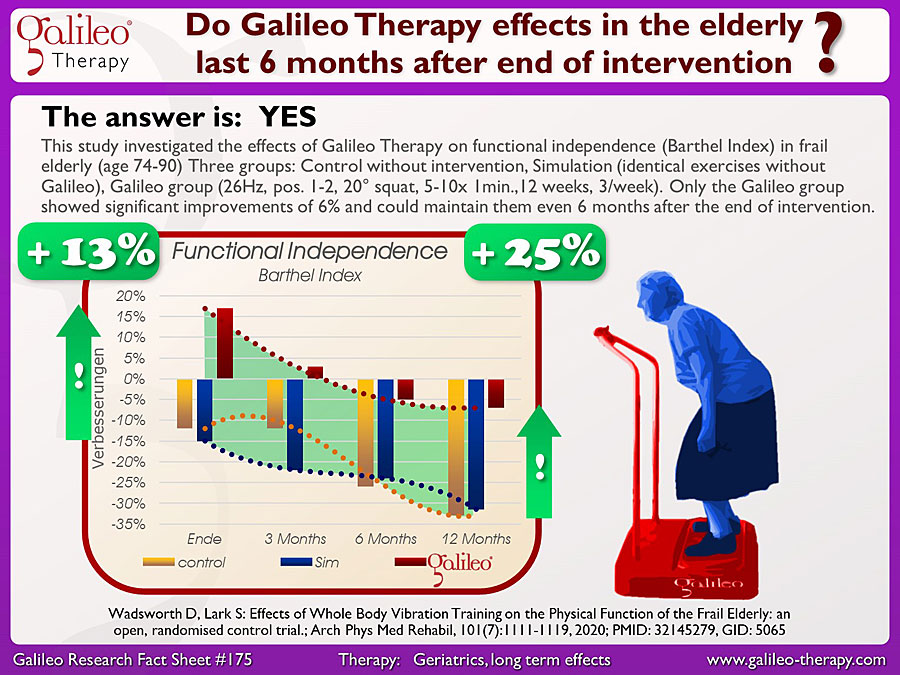This study investigated the effects of Galileo Therapy on functional independence (Barthel Index) in frail elderly (age 74-90) Three groups: Control without intervention, Simulation (identical exercises without Galileo), Galileo group (26Hz, pos. 1-2, 20° squat, 5-10x 1min.,12 weeks, 3/week). Only the Galileo group showed significant improvements of 6% and could maintain them even 6 months after the end of intervention...
This study investigated the effects of Galileo Therapy on muscle function (6MTW, CRT) in Interstitial Lung Diseases (ILD) (Age: 49-75). Galileo group: 30° squat, 3x3min, 26Hz, pos. 2-3, 16 weeks, 3/week, Control: identical exercises without Galileo. The Galileo group showed significant improvements in muscle function in 6MWT (+6%) and CRT (+13%) and at the same time an decrease in the inflammation parameter IL-6 (-33%)...
This study investigated the effects of Galileo Therapy in Cerebral Palsy (CP, GMFCS 1&2, age 5-9) (Cologne Concept: 3x3 minutes, 10 session/week, 26 weeks) on walking distance (1MWT). Galileo Therapy showed a significant increase after 6 months (+17%) while there was no further increase in the following 6 months without Galileo but with individual standard therapy...
This study investigated the effects of Galileo Therapy on muscle function an balance in frail elderly (age 74-90) Three groups: Control without intervention, Simulation (identical exercises without Galileo), Galileo group (26Hz, pos. 1-2, 20° squat, 5-10x 1min.,12 weeks, 3/week). The Galileo group showed significant functional improvements of up to +14% while the other groups showed decrease in all parameters of up to -24%...
This study investigated effects of Galileo Therapy (3x3 min., 20Hz, pos. 2-3, 4/week, 20 weeks) in adolescents with Down Syndrome (age 10-19). The results after 20 weeks showed significant improvements in muscle function in endurance during 6MWT (distance: +12%) as well as movement efficiency (jump: +11%) or power in chair rise test (CRT, power: +15%, duration: -25%) and jump for maximum height (jumping height: +28%)...
This study investigated the effects of treadmill therapy and Galileo Therapy in Parkinson’s patients on training intensity (oxygen uptake) as well as regeneration (4 weeks, 4/week: 4x5 min. walking vs. 10x1 Min Galileo, 26Hz, pos. 4, static semi squat). The Galileo group showed increased oxygen uptake (+41%) after 20 minutes but at the same time a significantly decreased regeneration time (EPOC, -37%)...
This study investigated short-term effects of Galileo Therapy (16-25Hz, pos. 1,5-3, 1 min., 10° knee angle, fore-foot stance) in children with spastic Cerebral Palsy (CP, GMFCS 2-4, 4-12 Jahre). The results show a massive decrease in cocontraction (26% to 54%) and hence and increase in voluntary muscle activation (#GRFS165). Both effects explain are essential for reduction of Spasticity when using Galileo Therapy...
This study investigated short-term effects of Galileo Therapy (16-25Hz, pos. 1,5-3, 1 min., 10° knee angle, fore-foot stance) in children with spastic Cerebral Palsy (CP, GMFCS 2-4, 4-12 Jahre). The mechanical reflex (-12%), active Range of Motion (+15%) and the voluntary muscle activation (+17, +37%) was measured. The observed significant improvements explain why Galileo Therapy is so effective in Spasticity Management...
This study investigated the effects of Galileo Therapy in Cerebral Palsy (CP, GMFCS 1&2, age 5-10) (Cologne Concept: 3x3 minutes, 10 session/week, 26 weeks) on walking distance (6MWT). Galileo Therapy showed a significant increase in walking distance after 6 months (+17%) while there was no further increase in the following 6 months without Galileo but with individual standard therapy...
This safety study investigated the effects of Galileo Therapy during intense chemotherapy in Leukemia. Galileo Therapy was compared to cycling ergometer training (20 min., 18-25Hz, pos. 3-4, 120° squat, 3/week, 2 weeks). The Galileo group showed significant muscle function improvements compared to the ergometer group with in Chair-rise power (+4%), jump height (+12%) as well as timed up & go test (TUG, +19%)...









